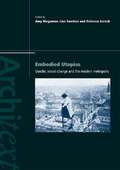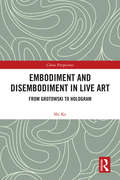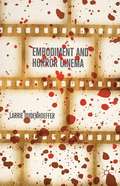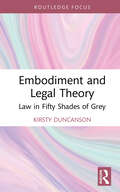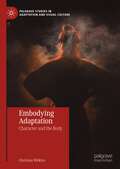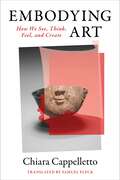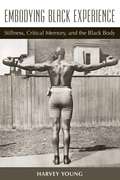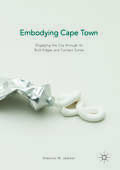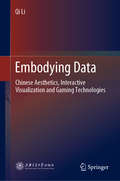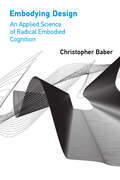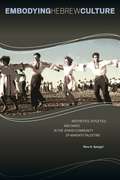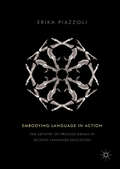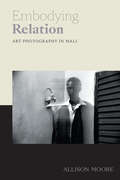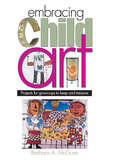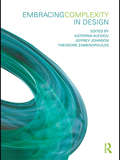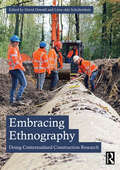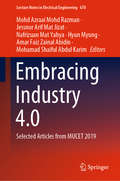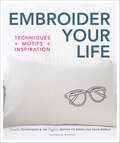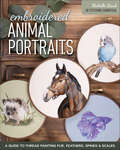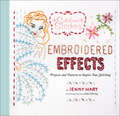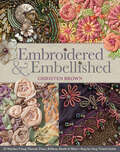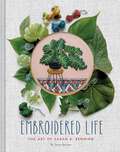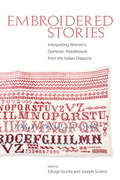- Table View
- List View
Embodied Utopias: Gender, Social Change and the Modern Metropolis (Architext)
by Amy Bingaman Lise Sanders Rebecca ZorachUtopia has become a dirty word in recent scholarship on modernism, architecture, urban planning and gender studies. Many utopian designs now appear impractical, manifesting an arrogant disregard for the lived experiences of the ordinary inhabitants who make daily use of global public and private spaces. The essays in Embodied Utopias argue that the gendered body is the crux of the hopes and disappointments of modern urban and suburban utopias of the Americas, Europe and Asia. They reassess utopian projects - masculinist, feminist, colonialist, progressive - of the late nineteenth and early twentieth centuries; they survey the dystopian landscapes of the present; and they gesture at the potential for an embodied approach to the urban future, to the changing spaces of cities and virtual landscapes.
Embodiment and Disembodiment in Live Art: From Grotowski to Hologram (China Perspectives)
by Ke ShiLiveness is a pivotal issue for performance theorists and artists. As live art covers both embodiment and disembodiment, many scholars have emphasized the former and interpreted the latter as the opposite side of liveness. In this book, the author demonstrates that disembodiment is also an inextricable part of liveness and presence in performance from both practical and theoretical perspectives. By applying phenomenological theory to live performance, the author investigates the possible realisation of aesthetic dynamics in live art via re-engagement with the notions of embodiment, especially in the sense provided by philosophers such as Gabriel Marcel and Morris Merleau-Ponty. Creative practices from leading performance artists such as Franko B, Ron Athey, Manuel Vason and others, as well as experimental ensembles such as Goat Island, La Pocha Nostra, Forced Entertainment and the New Youth are discussed, offering a new perspective to re-frame human-human relationships such as the one between actor and spectator and collaborations in live genres In addition, the author presents a new interpretation model for the human-material in live genres, helping to bridge the aesthetic gaps between performance art and experimental theatre and providing an ecological paradigm for performance art, experimental theatre and live art.
Embodiment And Horror Cinema
by Larrie DudenhoefferUsing the four tissue types (connective, epithelial, nervous, and muscular), Dudenhoeffer expands and complicates the subgenre of "body horror. " Changing the emphasis from the contents of the film to the "organicity" of its visual and affective registers, he addresses the application of psychoanalysis, phenomenology, object-ontology, and cyborgism.
Embodiment and Legal Theory: Law in Fifty Shades of Grey
by Kirsty DuncansonThis book addresses the importance of the body in legal theory, through an analysis of the film Fifty Shades of Grey.As physical beings, we experience law in sensations of outrage when it is applied unethically, righteousness when it finds justice, and joy when it establishes partnerships in marriage. Our bodies feel and know law. In Embodiment and Legal Theory, it is argued that our bodies also theorise law. It is proposed that our bodies are involved in comprehending, negotiating, and reimagining the legal concepts that shape our lives. As a medium designed to engage us by stimulating our bodily reactions of tears, laughter, shock, and titillation, cinema provides an ideal site for exploring how bodies participate in legal arguments and the construction of legal meaning. For this reason, through a deep analysis of the film Fifty Shades of Grey (2015), this book presents a theory of embodied jurisprudence.At the intersection of legal theory and film studies, this book will appeal to students and scholars in both these areas, as well as in criminology and cultural studies.
Embodying Adaptation: Character and the Body (Palgrave Studies in Adaptation and Visual Culture)
by Christina WilkinsThis book explores the impact of the body on the mediation of character in adaptations. Specifically, it thinks about how identity is shaped by the body and how this alters meanings of adaptations. With an increasingly digital world, the importance of the body may be seen as diminishing. However, the book highlights the different political and social meanings the body signifies, which in turn renders character. Through a discussion of adaptations of sexuality, race, and mental difference, the mediation of character is shown to be tied to the physical. The book challenges the hierarchies in place both for the understanding of character, which privileges the actor, and in adaptations, which privileges the original. The discussion of the body, character, and adaptation asserts that the meanings the physical has in its shaping of, and by, character in adaptations reflect the way in which we position our own bodies in the world.
Embodying Art: How We See, Think, Feel, and Create
by Chiara CappellettoIn recent years, neuroscientists have made ambitious attempts to explain artistic processes and spectatorship through brain imaging techniques. But can brain science really unravel the workings of art? Is the brain in fact the site of aesthetic appreciation?Embodying Art recasts the relationship between neuroscience and aesthetics and calls for shifting the focus of inquiry from the brain itself to personal experience in the world. Chiara Cappelletto presents close readings of neuroscientific and philosophical scholarship as well as artworks and art criticism, identifying their epistemological premises and theoretical consequences. She critiques neuroaesthetic reductionism and its assumptions about a mind/body divide, arguing that the brain is embodied and embedded in affective, cultural, and historical milieus.Cappelletto considers understandings of the human brain encompassing scientific, philosophical, and visual and performance arts discourses. She examines how neuroaesthetics has constructed its field of study, exploring the ways digital renderings and scientific data have been used to produce the brain as a cultural and visual object. Tracing the intertwined histories of brain science and aesthetic theory, Embodying Art offers a strikingly original and profound philosophical account of the human brain as a living artifact.
Embodying Black Experience: Stillness, Critical Memory, and the Black Body
by Harvey Young"Young's linkage between critical race theory, historical inquiry, and performance studies is a necessary intersection. Innovative, creative, and provocative. " ---Davarian Baldwin, Paul E. Raether Distinguished Professor of American Studies, Trinity College In 1901, George Ward, a lynching victim, was attacked, murdered, and dismembered by a mob of white men, women, and children. As his lifeless body burned in a fire, enterprising white youth cut off his toes and, later, his fingers and sold them as souvenirs. InEmbodying Black Experience, Harvey Young masterfully blends biography, archival history, performance theory, and phenomenology to relay the experiences of black men and women who, like Ward, were profoundly affected by the spectacular intrusion of racial violence within their lives. Looking back over the past two hundred years---from the exhibition of boxer Tom Molineaux and Saartjie Baartman (the "Hottentot Venus") in 1810 to twenty-first century experiences of racial profiling and incarceration---Young chronicles a set of black experiences, or what he calls, "phenomenal blackness," that developed not only from the experience of abuse but also from a variety of performances of resistance that were devised to respond to the highly predictable and anticipated arrival of racial violence within a person's lifetime. Embodying Black Experiencepinpoints selected artistic and athletic performances---photography, boxing, theater/performance art, and museum display---as portals through which to gain access to the lived experiences of a variety of individuals. The photographs of Joseph Zealy, Richard Roberts, and Walker Evans; the boxing performances of Jack Johnson, Joe Louis, and Muhammad Ali; the plays of Suzan-Lori Parks, Robbie McCauley, and Dael Orlandersmith; and the tragic performances of Bootjack McDaniels and James Cameron offer insight into the lives of black folk across two centuries and the ways that black artists, performers, and athletes challenged the racist (and racializing) assumptions of the societies in which they lived. Blending humanistic and social science perspectives,Embodying Black Experienceexplains the ways in which societal ideas of "the black body," an imagined myth of blackness, get projected across the bodies of actual black folk and, in turn, render them targets of abuse. However, the emphasis on the performances of select artists and athletes also spotlights moments of resistance and, indeed, strength within these most harrowing settings. Harvey Young is Associate Professor of Theatre, Performance Studies, and Radio/Television/Film at Northwestern University. A volume in the series Theater: Theory/Text/Performance
Embodying Cape Town
by Shannon M. JacksonThis book examines the reciprocity that exists between the body and the urban built environment. It will draw on archival and ethnographic research as well as an interdisciplinary literature on cultural materialism, semiotics, and aesthetics to challenge dualist interpretations of four different points of historical-material contact in Cape Town, South Africa. Each chapter attends to different groups, social practices, and historical periods, but all share the fundamental questions: how does material culture reflect the way social agents make meaning through bodily contact with urban built form, and how does such meaning challenge the ways bodies are objectified? Further, how can we make sense of the historical processes embedded in the objectification of bodies without treating the social and the material, the mental and the physical as separate realities?
Embodying Data: Chinese Aesthetics, Interactive Visualization and Gaming Technologies
by Qi LiThis book investigates a new interactive data visualisation concept that employs traditional Chinese aesthetics as a basis for exploring contemporary digital technological contexts. It outlines the aesthetic approach, which draws on non-Western aesthetic concepts, specifically the Yijing and Taoist cosmological principles, and discusses the development of data-based digital practices within a theoretical framework that combines traditional Taoist ideas with the digital humanities. The book also offers a critique of the Western aesthetics underpinning data visualisation, in particular the Kantian sublime, which prioritises the experience of power over the natural world viewed at a distance. Taoist philosophy, in contrast, highlights the integration of the surface of the body and the surface of nature as a Taoist body, rather than promoting an opposition of mind and body. The book then explores the transformational potential between the human body and technology, particularly in creating an aesthetic approach spanning traditional Chinese aesthetics and gesture-based technology. Representing a valuable contribution to the digital humanities, the book helps readers understand data-based artistic practices, while also bringing the ideas of traditional Chinese aesthetics to Western audiences. In addition, it will be of interest to practitioners in the fields of digital art and data visualisation seeking new models.
Embodying Design: An Applied Science of Radical Embodied Cognition
by Christopher BaberRethinking design through the lens of embodied cognition provides a novel way of understanding human interaction with technology. In this book, Christopher Baber uses embodied cognition as a lens through which to view both how designers engage in creative practices and how people use designed artifacts. This view of cognition as enactive, embedded, situated, or distributed, without recourse to internal representations, provides a theoretical grounding that makes possible a richer account of human interaction with technology. This understanding of everyday interactions with things in the world reveals opportunities for design to intervene. Moreover, Baber argues, design is an embodied activity in which the continual engagement between designers and their materials is at the heart of design practice. Baber proposes that design and creativity should be considered in dynamic, rather than discrete, terms and explores &“task ecologies&”—the concept of environment as it relates to embodied cognition. He uses a theory of affordance as an essential premise for design practice, arguing that affordances are neither form nor function but arise from the dynamics within the human-artifact-environment system. Baber explores agency and intent of smart devices and implications of tangible user interfaces and activity recognition for human-computer interaction. He proposes a systems view of human-artifact-environment interactions—to focus on any one component or pairing misses the subtleties of these interactions. The boundaries between components remain, but the borders that allow exchange of information and action are permeable, which gives rise to synergies and interactions.
Embodying Hebrew Culture: Aesthetics, Athletics, and Dance in the Jewish Community of Mandate Palestine
by Nina S. SpiegelFrom their conquest of Palestine in 1917 during World War I, until the establishment of the State of Israel in 1948, the British controlled the territory by mandate, representing a distinct cultural period in Middle Eastern history. In Embodying Hebrew Culture: Aesthetics, Athletics, and Dance in the Jewish Community of Mandate Palestine, author Nina S. Spiegel argues that the Jewish community of this era created enduring social, political, religious, and cultural forms through public events, such as festivals, performances, and celebrations. She finds that the physical character of this national public culture represents one of the key innovations of Zionism-embedding the importance of the corporeal into national Jewish life-and remains a significant feature of contemporary Israeli culture. Spiegel analyzes four significant events in this period that have either been unexplored or underexplored: the beauty competitions for Queen Esther in conjunction with the Purim carnivals in Tel Aviv from 1926 to 1929, the first Maccabiah Games or "Jewish Olympics" in Tel Aviv in 1932, the National Dance Competition for theatrical dance in Tel Aviv in 1937, and the Dalia Folk Dance Festivals at Kibbutz Dalia in 1944 and 1947. Drawing on a vast assortment of archives throughout Israel, Spiegel uses an array of untapped primary sources, from written documents to visual and oral materials, including films, photographs, posters, and interviews. Methodologically, Spiegel offers an original approach, integrating the fields of Israel studies, modern Jewish history, cultural history, gender studies, performance studies, dance theory and history, and sports studies. In this detailed, multi-disciplinary volume, Spiegel demonstrates the ways that political and social issues can influence a new society and provides a dynamic framework for interpreting present-day Israeli culture. Students and teachers of Israel studies, performance studies, and Jewish cultural history will appreciate Embodying Hebrew Culture.
Embodying Language in Action: The Artistry of Process Drama in Second Language Education
by Erika PiazzoliThis book explores embodiment in second language education, sociocultural theory and research. It focuses on process drama, an embodied approach that engages learners’ imagination, body and voice to create a felt-experience of the second language and culture. Divided into three parts, it begins by examining the aesthetic and intercultural dimension of performative language teaching, the elements of drama and knowing-in-action. The central part of the book examines issues related to play, emotions, classroom discourse and assessment when learning a language through process drama, in a sociocultural perspective. The third part is an analysis of the author’s qualitative research, which informs a subtle discussion on reflective practitioner methodology, learner engagement and teacher artistry. Each chapter includes a drama workshop, illustrating in practice what embodying language in action can look like when working with asylum seekers, adult learners with intellectual disabilities, pre-service teachers, international students and children involved in a Content and Language Integrated Learning (CLIL) programme. A unique combination of theory, research and reflective practice, this book provides valuable insights for teacher/artists, teacher educators and researchers in the fields of performative and sociocultural language learning.
Embodying Relation: Art Photography in Mali (Art History Publication Initiative)
by Allison MooreIn Embodying Relation Allison Moore examines the tensions between the local and the global in the art photography movement in Bamako, Mali, which blossomed in the 1990s after Malian photographers Seydou Keïta and Malick Sidibé became internationally famous and the Bamako Photography Biennale was founded. Moore traces the trajectory of Malian photography from the 1880s—when photography first arrived as an apparatus of French colonialism—to the first African studio practitioners of the 1930s and the establishment in 1994 of the Bamako Biennale, Africa's most important continent-wide photographic exhibition. In her detailed discussion of Bamakois artistic aesthetics and institutions, Moore examines the post-fame careers of Keïta and Sidibé, the biennale's structure, the rise of women photographers, cultural preservation through photography, and how Mali's shift to democracy in the early 1990s enabled Bamako's art scene to flourish. Moore shows how Malian photographers' focus on cultural exchange, affective connections with different publics, and merging of traditional cultural precepts with modern notions of art embody Caribbean philosopher and poet Édouard Glissant's notion of “relation” in ways that spark new artistic forms, practices, and communities.
Embracing Child Art: Projects for Grown-ups to Keep and Treasure
by Barbara A. McguireReaders will find fresh ways to celebrate children's artistic expressions with these unique ideas from Barbara A. McGuire, author of Foundations in Polymer Clay Design and Wire in Design. Learn how to transform children's drawings into functional pieces that will be cherished forever - from an Op Art Lantern for the living room to elegant jewelry to wear with pride. This book is not only for parents, but also for grandparents, troop leaders, and elementary school teachers - any adult interested in preserving the artistic endeavors of children everywhere. The 15 projects presented will take elements of the child's art and apply it to an adult craft. McGuire explains many of the basic principles of design, as well as the elements that all child art shares while guiding the reader through a variety of media applications including polymer clay, paper, ceramics, glass, wood, paint and more. Learn how to immortalize children's expressive art, while forging bonds that encourage and promote their unique creations. 15 unique and creative projects to preserve the artistic endeavors of any child Fully illustrated with step-by-step instructions for each project Basic principles of design and elements of child art
Embracing Complexity in Design
by Katerina Alexiou Jeffrey Johnson Theodore ZamenopoulosOutlining state-of-the-art developments in the area of complexity and design, this book collates them into a unique and authoritative resource for both the design and complex systems communities. The book is based on research which focuses on a variety of different themes and domains, including architecture, engineering, environmental design, art, fashion and management. A ground-breaking publication marking a new era of appreciation of the import of complexity on design, this book is essential reading for those studying complexity or design.
Embracing Ethnography: Doing Contextualised Construction Research
by David Oswald Léon Olde ScholtenhuisThis book calls for those interested in robust construction research to embrace ethnography – in all its forms, including rapid ethnographies, ethnographic-action research, autoethnography, as well as longer-term ethnographies.The diversification of ethnographic approaches, as well as ethnographers, will lead to rich insights that can advance the industry theoretically and practically. We share experiences, key considerations and recommendations from leading construction ethnographic researchers from around the world to provide discussion, reflection and understanding into doing ethnography in the construction industry.This book is aimed at academics, students, consultants, editors, reviewers, policymakers, funders and others interested in robust research in the construction industry and built environment but will also be useful for those undertaking research within organisations in other industries.
Embracing Industry 4.0: Selected Articles from MUCET 2019 (Lecture Notes in Electrical Engineering #678)
by Mohd Azraai Mohd Razman Jessnor Arif Mat Jizat Nafrizuan Mat Yahya Hyun Myung Amar Faiz Zainal Abidin Mohamad Shaiful Abdul KarimThis book highlights selected articles from the electrical engineering track, with a focus on the latest trends in electrical and electronic engineering toward embracing Industry 4.0, as part of the Malaysian Technical Universities Conference on Engineering and Technology—MUCET 2019. The event brings together researchers and professionals in the fields of engineering, research, and technology, and provides a platform for future collaborations and exchanges.
Embroider Your Life: Simple Techniques & 150 Stylish Motifs to Embellish Your World
by Nathalie MornuEmbellish your world with 150 motifs designed by 20 of today's most popular embroidery artists of Instagram and Etsy! Perfect for beginners, Embroider Your Life is a beautiful, inspirational, step-by-step visual guide for all things embroidery. You&’ll learn the simplest embroidery stitches and techniques, and see the creative ways embellishments can be used to personalize your head-to-toe wearables, accessories, and home goods! Here&’s what you&’ll find in Embroider Your Life: · 150 stylish and modern motifs for people, numbers and words, animals and plants, geometric patterns, frames and wreaths, and much more · 4 detailed, step-by-step projects for stitching on paper, shadow work, sashiko, and stitching a house from a photo · Beautiful color photography and detailed illustrations to inspire your creativity and spark your imagination · Guidance on choosing tools and materials including hoops, thread types, and fabrics · Instructions for transferring motifs to materials, performing basic stitches, mounting fabric on a stretcher, fabric appliqué, and more
Embroidered Animal Portraits: A Guide to Thread Painting Fur, Feathers, Spines & Scales
by Michelle StaubCreate stunningly realistic embroidered animal masterpieces Our beloved pets hold a special place in our hearts; we want to capture them in stitches whether they’re covered in fur, scales, or feathers! Join embroidery artist Michelle Staub to immortalize your pets with thread painting. From an adorable rabbit and guinea pig, to a colorful parakeet and stately lizard, you’ll stitch through 12 animal projects that teach you to create a much wider variety of pet portraits. With all the information you need to get started, including supplies, basic stitches, stitch patterns, and color guides, Embroidered Animal Portraits is your handbook for creating strikingly realistic and personalized embroidered masterpieces. Expanding on her first bestselling book, Pet Portrait Embroidery, Michelle Staub offers instruction on stitching a new variety of textures with non-traditional pets, including a hen, hedgehog, snake, and horse! From start to finish, learn to turn an animal photo into a realistic thread painting that captures lighting, detail, and personality. Includes embroidery basics, patterns, and 12 step-by-step animal projects, ranging in skill level from beginner accessible, to intermediate stitcher.
Embroidered Effects: Projects and Patterns to Inspire Your Stitching (Sublime Stitching)
by Aimee Herring Jenny HartNow in ebook for the first time ever! Embroidery empress Jenny Hart taught her legion of fans the basics with the best-selling Stitch-It Kit and Sublime Stitching. Now, for the first time ever in digital format, she takes stitchers one step further with instructions and diagrams for more than 35 stitches. This very special ebook includes the text from the print version, plus instructions for how to print the patterns and iron-on transfers. With lots of project photos for guidance, even beginners can learn how to stitch faux tattoos on their shirt sleeves, cheeky fan dancers on their shower curtains, and many more fun projects.
Embroidered & Embellished: 85 Stitches Using Thread, Floss, Ribbon, Beads & More
by Christen BrownThe complete visual guide to hand embroidery & embellishing. This richly illustrated reference guide from embroidery expert Christen Brown covers everything you need to make beautiful magic with needle and thread. Learn to sew traditional and silk ribbon embroidery, make raised stitches, and embellish with beads, charms, buttons, and mirrors. Christen shows you how to combine and place stitches to enhance a finished piece and how to work with embroidery threads, ribbons, fabrics, laces, beads, buttons, and other embellishments. • Step-by-step photo instructions show exactly how to sew 85 different stitches • Includes eight complete embroidery projects to stitch and embellish • The essential embroidery reference for everyone from beginners to experts&“A cornucopia of fancy stitches. . . . Even experienced stitchers are likely to learn something new . . . . As a catalogue of possibility for stitching, this is a wonderful addition to a crafting library.&” —Publishers Weekly&“This book surpassed my expectations, which rarely happens. Kudos to C&T and the author for putting together an excellent, comprehensive book on this topic. I have been doing embroidery of all kinds for several years and was delighted to see new (to me) stitches and combinations. The projects are beautiful and inspiring.&” —Cindy Gorder, editor, Decorating Digest Craft & Home Projects&“A wonderful visual guide to 85 stitches that use thread, floss, ribbon, beads and more. . . . If you are new to embroidery, Christen offers a good discussion on the materials to use. I thought her Embroidering With Confidence chapter offered lots of good tips for the novice as well as a refresher for those who have not picked up an embroidery needle for a while.&”—The Professional Quilter Magazine
Embroidered Life: The Art of Sarah K. Benning
by Sara BarnesEmbroidered Life shows that illustrations created with needle and thread can be strikingly contemporary and absolutely breathtaking.This is not your grandma's embroidery book: From beautiful botanicals to bold affirmations, the work of self-taught fiber artist Sarah K. Benning gives any embroidery enthusiast, art lover, or plant fanatic a new appreciation for the craft of needlework.• Learn the intricacies of Benning's innovative embroidery process and successful business model, offering behind-the-scenes insights to inspire makers and creative entrepreneurs• Brightly colored photographs of her work are displayed throughout with written notes explaining the meaning and process behind the stitches• Stunning photographs of her best work captures the essence of her needlework and helps to inspires the readers own creativity• Features a die-cut case with actually stitching on the front cover, making it an attractive, touchable coffee table bookFans of Punch Needle and Almost Lost Arts will also enjoy learning about the way embroidery floss becomes stunning works of art.• Sarah K. Benning is a contemporary embroidery artist based in New Hampshire who creates highly detailed, hand-stitched works; writes DIY patterns for other embroidery practitioners; and teaches workshops all over the world• Sara Barnes is a freelance writer and artist, and author of the blog Brown Paper Bag• Embroidered Life makes an inspiring gift for any artist or avid crafter
Embroidered Stories: Interpreting Women's Domestic Needlework from the Italian Diaspora
by Edvige Giunta and Joseph SciorraFor Italian immigrants and their descendants, needlework represents a marker of identity, a cultural touchstone as powerful as pasta and Neapolitan music. Out of the artifacts of their memory and imagination, Italian immigrants and their descendants used embroidering, sewing, knitting, and crocheting to help define who they were and who they have become. This book is an interdisciplinary collection of creative work by authors of Italian origin and academic essays. The creative works from thirty-seven contributors include memoir, poetry, and visual arts while the collection as a whole explores a multitude of experiences about and approaches to needlework and immigration from a transnational perspective, spanning the late nineteenth century to the late twentieth century. At the center of the book, over thirty illustrations represent Italian immigrant women's needlework. The text reveals the many processes by which a simple object, or even the memory of that object, becomes something else through literary, visual, performance, ethnographic, or critical reimagining. While primarily concerned with interpretations of needlework rather than the needlework itself, the editors and contributors to Embroidered Stories remain mindful of its history and its associated cultural values, which Italian immigrants brought with them to the United States, Canada, Australia, and Argentina and passed on to their descendants.
Embroidering Her Truth: Mary, Queen of Scots and the Language of Power
by Clare HunterAn alternative biography of Mary, Queen of Scots through the textiles of her life from the author of Sunday Times bestseller Threads of Life.I felt that Mary was there, pulling at my sleeve, willing me to appreciate the artistry, wanting me to understand the dazzle of the material world that shaped her.At her execution Mary, Queen of Scots wore red. Widely known as the colour of strength and passion, it was in fact worn by Mary as the Catholic symbol of martyrdom.In sixteenth-century Europe women's voices were suppressed and silenced. Even for a queen like Mary, her prime duty was to bear sons. In an age when textiles expressed power, Mary exploited them to emphasise her female agency. From her lavishly embroidered gowns as the prospective wife of the French Dauphin to the fashion dolls she used to encourage a Marian style at the Scottish court and the subversive messages she embroidered in captivity for her supporters, Mary used textiles to advance her political agenda, affirm her royal lineage and tell her own story.In this eloquent cultural biography, Clare Hunter exquisitely blends history, politics and memoir to tell the story of a queen in her own voice.(P) Hodder & Stoughton Limited
Embroidering Her Truth: Mary, Queen of Scots and the Language of Power
by Clare HunterI felt that Mary was there, pulling at my sleeve, willing me to appreciate the artistry, wanting me to understand the dazzle of the material world that shaped her.At her execution Mary, Queen of Scots wore red. Widely known as the colour of strength and passion, it was in fact worn by Mary as the Catholic symbol of martyrdom.In sixteenth-century Europe women's voices were suppressed and silenced. Even for a queen like Mary, her prime duty was to bear sons. In an age when textiles expressed power, Mary exploited them to emphasise her female agency. From her lavishly embroidered gowns as the prospective wife of the French Dauphin to the fashion dolls she used to encourage a Marian style at the Scottish court and the subversive messages she embroidered in captivity for her supporters, Mary used textiles to advance her political agenda, affirm her royal lineage and tell her own story.In this eloquent cultural biography, Clare Hunter exquisitely blends history, politics and memoir to tell the story of a queen in her own voice.
